
March 2024
Solving the Bike Lane Challenge
Municipalities Nationwide Look to Products that Help Improve Safety for Bicyclists, Pedestrians and Motorists
Bicycle use has been on the rise in the United States since the onset of the COVID-19 pandemic. In fact, between 2019 and 2022, the annual national average for daily bike trips saw a 37% increase.
Much of this growth occurs in cities, with the nation’s 100 largest metropolitan areas accounting for 77% of bike activity. This is up from 72% in 2019. The statistics reveal that more Americans are choosing to use bicycles for transport. The nation’s infrastructure is growing to be more inclusive of these efforts with many major metropolitan areas undertaking a comprehensive redesign of their bike lanes. Investments in such upgrades require the right planning, products and best practices to achieve safety for all users.
PPG’s Traffic Solutions business has driven innovation in pavement markings to support such investments. ENNIS-FLINT® by PPG MMAX® Extended Season material is a newly invented coating that advances MMA technology with the widest range of pavement application temperatures and offers excellent color retention, grip and lifespan. This premium marking is an ally in helping cities and towns make strides in their bicycle infrastructure efforts.

Bike Lane Types
A major component of growing bicycle infrastructure is ensuring that roadways can support both vehicle and bicyclist traffic. Cities have utilized several approaches to ridership with shared lanes being the most common and most affordable.
The issue with this approach is a lack of partition or any protective measures that reduce the risk of bicyclists being struck by passing vehicles. Separation between the two is critical, with agencies like the Federal Highway Administration and National Transportation Safety Board providing endorsement.
Culturally, many drivers also deride such layouts for their disruptive flow, with frustrations too often being directed at the bicyclist.
An alternative is a dedicated bike lane. Though this requires more investment from cities, a marked lane is created for bicyclists to utilize, often on the road shoulder. While generally safer than shared lanes, dedicated lanes are still risky, with a barrier between vehicle and bicyclist still absent, even in instances where road markings indicate a buffer between the two lanes.
The gold standard for riders is a protected bicycle lane where street parking is not curbside. Instead, parked vehicles act as a physical barrier between passing traffic and bicyclists. Such layouts are the safest option for riders with a far lower likelihood of being struck by a vehicle.
Regardless of the bike lane type, it is critical that cities clearly mark the roadway to help ensure bicyclists can be easily spotted when riding alongside traffic.

The Right Coating for Infrastructure Investment
Motorists must constantly remain attentive to road conditions, signs and instructions, potential hazards and traffic congestion. It is vital for bicyclists to be seen on the roadways, particularly because collisions with vehicles too often result in the bicyclist’s death.
Proper investments in bicycle infrastructure require towns and cities in the United States to specify road surface coatings that can aid in this collective endeavor. Methyl methacrylate (MMA) road markings must endure climate considerations and high traffic while still retaining their color for several years.
Unlike traditional MMA technologies that cannot be applied if the road surface is too hot, Extended Season MMAX area markings can be applied to pavement surfaces from 35° F to as hot as 150° F (66°C). This feature helps municipalities maximize productivity with fewer work stoppages for temperatures that are simply too hot for using traditional coatings. Because the markings can be applied at higher temperatures year-round, work can be performed during the hottest hours of the day, providing fewer traffic restrictions during peak commuting times.
Extended Season MMAX area markings help towns ensure road safety investments are more beneficial. The skid-resistant coating offers an easier application experience with triple the working time of other MMA products on surfaces at 110° F (43°C) or more. The result is a high-visibility coating that elevates the visibility of dedicated lanes for bicyclists, pedestrians and motorists alike.

Helping Elevate Safety
The numbers tell the story. Americans are turning to bicycles on a more regular basis. Among adults surveyed in the United States, 46% have access to a bicycle. Of that number, 54% had used a bicycle in the month immediately before they were surveyed.
That means metropolitan areas small and large are faced with increased responsibility to create a cityscape where cars, bikes and pedestrians can co-exist. The driving force is to reduce the risk of accidents and injuries.
When it comes to durable pavement markings for dedicated bike lanes, Ennis-Flint by PPG MMAX Extended Season area markings are providing a powerful tool for decision makers, one that can lead to enhanced safety for residents and visitors alike no matter their mode of transportation.